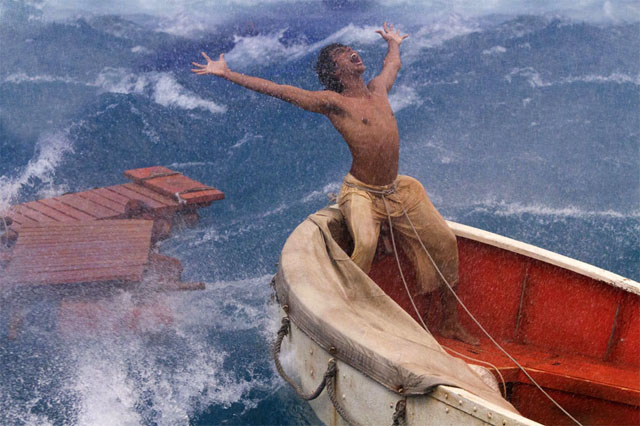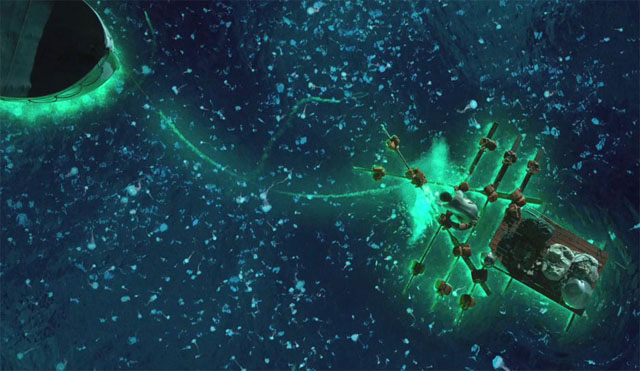“‘There’s some good advice in the film business: Never make a movie about kids, animals or water… and you’ll see them all here,’ [Ang] Lee told an audience Friday night at the opening of the New York Film Festival,” reports Steven Zeitchik in the Los Angeles Times. “Then he unveiled his digitally enabled 3D movie for the first time, drawing rapturous applause in what ranks as one the strongest opening-night responses the festival has seen in recent years. Starring Indian newcomer Suraj Sharma and written by David Magee, the film tells of Pi Patel (Sharma), a boy growing up in India as the son of a zookeeper. When his father decides to move the family to Canada, they attempt to take the animals with them. But an ensuing shipwreck leaves his parents dead and Pi stuck on a tiny life boat with a Bengali tiger named Richard Parker.”
“From its first image, of a small bear hugging a tree as a hummingbird fluttering above it—and seemingly flies through the movie house—the movie declares its intention to astound the viewer with the hitherto untapped properties of 3D,” writes Time‘s Richard Corliss. Life of Pi “builds on the innovations in stereoscopy triumphantly heralded by James Cameron’s Avatar, and the advances in motion-capture technology evident in Rise of the Planet of the Apes, to create a tactile, spectacular world of wonder…. Pi is a giant leap forward, outward and upward in expanding the resources of the evolving medium of movies. Magical realism was rarely so magical and never before so real.”
Hold on, let’s not go overboard, warns Vadim Rizov at Box Office: “Dramatically, Life of Pi is a mess, opening with the grown-up Pi (Irrfan Khan) telling his story to a curious novelist (Rafe Spall), the pretext for a mess of exposition-heavy voiceover that largely disappears when the building blocks are in place. The writer’s there because he heard Pi’s in possession of ‘a story that will make me believe in God.’ Cast into a Book of Job-esque situation (the pace takes on a one-damn-thing-after-another choppiness), Pi’s eventually reduced to yelling ‘I am your vessel’ at the indifferent skies, but his eventual salvation confirms that God’s there, above, rewarding his tested patience. All this is explicitly, endlessly verbalized lest anyone miss the point—not just about belief, but about the leap of faith required of stories both religious and secular. But really, Life of Pi asks less of its story. It’s merely a technical achievement with predigested, unoriginal themes.”
“Mr. Lee, who is gentle and soft-spoken in life, has always been fearless in his cinematic choices,” writes Anupama Chopra in a profile for the New York Times. “In a career spanning 20 years he has continually jumped across genres. The Lee oeuvre includes a Jane Austen novel (Sense and Sensibility), a Chinese martial-arts epic (Crouching Tiger, Hidden Dragon), a comic-book adaptation (Hulk) and the deeply moving love story of two cowboys, for which he won the best director Oscar in 2006—Brokeback Mountain. Still, it took Mr. Lee two months before he agreed to take on [Yann] Martel’s complex book… Adapting Life of Pi had been considered by others since Fox Studios acquired the film rights to the book in 2003 (including M. Night Shyamalan and Alfonso Cuarón). Not only were there long stretches during which nothing happens, but the book is open to many interpretations, literal and metaphorical. ‘I loved the book,’ he said, ‘but it’s very hard to crack. I thought you can’t make a movie about religion but it can be a movie about the value of storytelling and how that brings structure and wisdom to life.'”
Lee and cinematographer Claudio Miranda “turn their visual restrictions into virtues,” writes Variety‘s Justin Chang. “The nimbly circling camera is forever finding compelling angles on the action… For all the splendor of the craftsmanship on display, from David Gropman’s eye-popping production design to Mychael Danna’s Indian-inflected score, what’s missing is a certain in-the-moment urgency. Compressing nearly eight months into roughly 75 minutes of screentime is a tricky task, and one never gets a sense of the agonizing duration of Pi’s experience, especially since the film tastefully sidesteps most of the raw, physically extreme details that made the novel so visceral. As much as it teems with color and creativity, Life of Pi could have used a bit more grit, substance and a touch of the grotesque. Even its warm-hearted plea for religious faith feels, in the end, like so much pantheistic fairy dust.”
“All three actors playing Pi are outstanding,” finds the Hollywood Reporter‘s Todd McCarthy. “The lion’s (or tiger’s) share of the burden falls on 17-year-old Suraj Sharma, the only human on view for half the time, obliged to act in a vacuum and convincingly represent all the physical demands. Lee looked at 3,000 candidates for the role (deliberately avoiding Bollywood talent) and found an unknown whose emotional facility is quite impressive. Ayush Tandon is captivating as the sponge that is young Pi, but absolutely imperative to the film’s success are the heart, lucidity and gravity Irrfan Khan provides as the grown-up Pi looking back at his experience.”
At Movies.com, David Ehrlich finds that the film “struggles to streamline the best seller into an emotionally coherent cinematic experience, but Life of Pi is also punctuated with some of the most thrilling sequences to have ever graced a movie screen, the film ultimately resolving itself as an indelible reminder that the cinema will never die so long as it continues to recognize that capturing reality isn’t nearly as interesting as letting it go.”
At the Playlist, Rodrigo Perez suggests that “perhaps what makes the picture better than both Avatar and Hugo is that character, soul and emotion are paramount in its mind over visual pyrotechnics. In fact, one could argue that, outside of a few stunning visual sequences, Life of Pi is not very reliant on 3D to tell its story, and that’s probably why the technology enhances the story, rather than elevates it.”
“At the third act twist, where things become a bit fantastic, it comes apart, and then ultimately whimpers off like a drenched cat,” finds Jordan Hoffman at Film.com. “The flat ending is quite a letdown, especially in comparison to just how much the rest of the film resonates.” IndieWIRE‘s Eric Kohn finds that “Life of Pi succeeds in its most audacious moments and struggles whenever it returns to familiar ground.”
Notes from the NYFF press conference: Sheerly Avni (Thompson on Hollywood), Brian Brooks (Movieline), and Peter Knegt (iW). Weighing Pi’s prospects as we head into awards season: Tom Shone, Kristopher Tapley, and Anne Thompson.
Update: And up pops a review at the Guardian from Tom Shone: “Lee melds so many disparate elements—Aesopian fable and cutting-edge 3D technology, east and west, young and old—that he may have just succeeded in rebranding himself as the Obama of world cinema. The fiercely urgent candidate of 2008, of course, not the stealth version currently working the stump…. Life of Pi feels warm-blooded, the perfect summation of the principle powering Lee’s entire career: still waters run deep. You see it both in the Zen minimalism of his compositions—check out the shots of sky reflected in a glassy ocean, the boat suspended in the middle as if hanging in thin air—and the sonar-like skill with which he sounds out the emotional depths of Martel’s tale. Lee’s pixels are animated by empathy.”
Updates, 10/2: “At its pandering worst,” writes Michael Koresky in Reverse Shot, “the film’s aesthetic can seem right out of the latter-day Tim Burton playbook; occasionally, however, Lee and the team of studio craftsman behind him create images of breathtaking digital elasticity with enough dreamy grandeur to compensate for the film’s meager, meandering spirituality. Some may find the emphatic special-effects-driven nature of Life of Pi simply gaudy and jejune, a cheapjack way of instilling awe in the viewer for a film that takes awe as its explicit subject; by boiling down Martel’s fable-like meditation on the act of storytelling to a childish essence, however, Lee has made something less concerned with the metaphysical than vividly contemplative about the power of cinematic imagemaking.”
R. Kurt Osenlund in Slant: “There’s a glut of big ideas beneath Life of Pi‘s surface, namely one’s relationship with God, but its strongest impression, communicated in pure terms with cutting-edge means, involves the humbling vastness of life, a universal notion that, here, transcends questions of belief.”
“The fine performances by its cast, as well as Ang Lee’s usual, and wonderful, sense of humanism and sympathy for people fighting against adversity, helps the film transcend its (if you’ll excuse the nautical analogy) waterlogged script,” finds Christopher Bourne, writing for Twitch.
“Pi is a Hindu-Buddhist-Christian-Arab, stirred with a Kabbalah twist. Why not a mint twig of Scientology?” asks Ryan Brown at Ioncinema. “The film even makes sure to give ‘rationality’ its place in the constellation of faiths. Lee is not nailing his 95 Theses to the movie screen. This calculated universality is not the result of a rigorous philosophy of comparative religion, but only a marketing strategy seeking to swarm multiple demographics.”
Viewing (32’00”). The press conference.
Update, 10/5: Gerard Raymond at the House Next Door: “Faithful to the book’s epilogue, Lee has Pi relate the alternate explanation for the engrossing yarn we have just witnessed in a static scene, delivered from a hospital bed. It’s a chunk of exposition and comes with the moral of fable spelled out. After nearly two hours of visual creativity it’s a wordy let down.”
Update, 10/14: “Life of Pi is narratively elegant, tonally gentle, and aesthetically immersive thanks partly to non-gimmicky 3D that adds enveloping depth and sumptuousness,” writes Nick Schager for the Voice. “But the movie is so torpid, preachy, faux-high-minded and ‘prestigious’ that it makes one desperately hunger for the nearest slice of B-movie sleaze.”
NYFF 2012: a guide to the coverage of the coverage. For news and tips throughout the day every day, follow @KeyframeDaily on Twitter and/or the RSS feed. Get Keyframe Daily in your inbox by signing in at fandor.com/daily.





